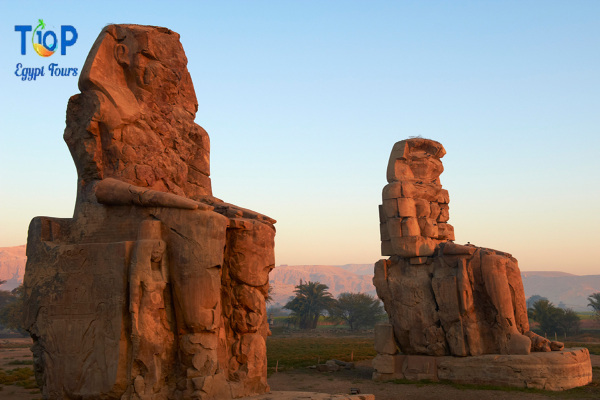Colossi of Memnon In Luxor, Welcome to “Historical Landmarks in Egypt,” a journey through the ancient wonders of this storied land. Today, we invite you to marvel at the awe-inspiring Colossi of Memnon, a testament to Egypt’s rich and majestic history.
The Story Of Colossi of Memnon In Luxor
Colossi of Memnon is located on the western side of the city of Thebes, which is known today as Luxor.
The two statues were in front of the entrance to an ancient funerary temple in memory of King Amenhotep III, one of the kings of the Eighteenth Dynasty, who ruled between 1417 and 1379 BC.
All that remains of the funerary temple are the two giant statues, up to 20 meters high
The two statues depict King Amenhotep III as he sits on the throne with a low support, placing his hands on his legs, with the royal crown above him. To the right of his legs is a small statue of his wife, Queen Ti, and to his left is a small statue of his mother, Mut Umm Weya. On both sides of the throne there is an inscription representing the gods of the Nile. The papyrus and lotus plants (Delta and Upper Egypt) connect the symbol of each, as a sign of the unification of the country.
The legend behind the name “Memnon”:
The two giant statues became known as the Colossi of Memnon as a result of an earthquake that occurred in 27 BC, which led to the collapse of the upper part of the northern statue and the cracking of some parts.
The northern statue became legendary after the earthquake, as it used to emit a strange sound whenever the wind passed through it. That is why the Greeks called the two statues “Memnon,” after the legendary Ethiopian hero called “Memnon,” who was killed by Achilles, the Greek legendary hero, in the Trojan War. .
According to legend, Eos, the mother of Memnon, the goddess of dawn, asked the god Zeus, the largest of the Greek gods, to distinguish her son from the rest of humanity, so Memnon would appear to her at dawn through this voice, and his mother would cry when she heard it. His voice, and her tears were dew drops.
The legend of the Colossi of Memnon and the phenomenon of the sound coming out of the northern statue became widespread, and the site attracted visitors from the Greeks, Romans, and other inhabitants of the ancient world, the most famous of whom were the Roman Emperor Hadrian and his wife.
The sounds stopped after the statue was restored, approximately in 200 AD.
For modern travelers and history enthusiasts, a visit to the Colossi of Memnon offers a captivating experience. As you stand in the presence of these towering figures, imagine the splendor of ancient Thebes and the kings who once walked these hallowed grounds.
Embracing the Legacy
As we pay homage to the Colossi of Memnon and their significance in Egypt’s historical tapestry, we are reminded of the enduring legacy of this remarkable civilization. From the grandeur of the ancient temples to the fascinating stories that echo through time, Egypt’s historical landmarks continue to inspire and captivate visitors from around the world.
Plan Your Journey
When crafting your itinerary to explore the historical landmarks of Egypt, consider including a visit to the Colossi of Memnon. Marvel at these remarkable statues, and immerse yourself in the grandeur and history of this timeless land.
Browse our complete list of Egypt tours Click Here



Comment (0)